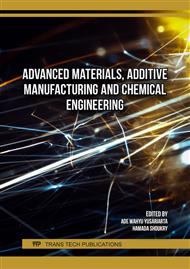p.47
p.63
p.79
p.91
p.103
p.117
p.123
p.131
p.141
Post-Curing and Layer Thickness Variations Effect on Tensile Strength of Resin 3D Print
Abstract:
Additive Manufacturing (AM), or as it is often called 3D printing, is the process of making objects by adding successive thin layers of material. One of the AM methods used is Digital Light Processing (DLP), which is a 3D printing technology that uses photopolymer resin (also known as UV Resin) as a manufacturing material. In the resin 3D printing process, several problems arise, such as the degree of drying which depends on the length of drying time and the difference in layer thickness which affects the material properties. Therefore, it is necessary to analyze how printing thickness parameter and drying (post-curing) time affect material properties, especially in terms of tensile strength values. This study used a variety of specimens, such as post-curing times of 90 minutes, 120 minutes, and 150 minutes with a layer thickness of 0.050 mm, as well as variations in layer thickness of 0.050 mm, 0.075 mm and 0.100 mm with a post-curing time of 150 minutes. Each specimen is printed and tested according to ASTM D638 standard. The results showed that the tensile strength values increased with increasing in post-curing time, and conversely, the tensile strength values decreased with increasing layer thickness. The longest post-curing time of 150 minutes and the thinnest layer thickness of 0.050 mm produce the highest tensile strength of 24.9 MPa.
Info:
Periodical:
Pages:
123-128
Citation:
Online since:
August 2025
Keywords:
Price:
Сopyright:
© 2025 Trans Tech Publications Ltd. All Rights Reserved
Share:
Citation:


